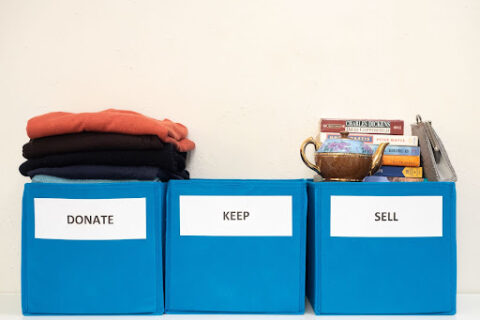Not only will successfully downsizing before the move make the move less expensive (smaller truck and fewer boxes), but downsizing will also make unpacking in your smaller space less stressful. Here are some simple tips that can help you make downsizing simpler.
-
Get Family in to Help When Possible
Most people seek help from family when facing a move, but when downsizing, your family can be even more helpful. Many parents have buckets of children’s keepsake items leftover from high school and college years. If you have children, make these items their responsibility so you have less on your plate.
Family can also help to take intended gifts and legacies off your hands. You might wish to leave your wedding dress to your daughter or niece. Now is the time to pass these things on, instead of waiting until after your death to disperse personal effects.
Speak with your family about the downsizing. Let them know that you might be passing these items on to them. Ask them to support you in your downsizing by taking the items without protest, but allow your family the freedom to do what they want with the things you give them.
-
Start as Soon as You Can
If you have several months of advance notice on your move, it’s best to get started as soon as you can. Nothing adds stress like a short timeline. When you have a calm approach, you can better determine which things you will have space to keep.
Begin in the “forgotten” areas of your home. Basements tend to collect items like Christmas decorations, coats that never get worn, old tools, electronics and items that only get seasonal use. These items are often less necessary, and they are therefore easier to part with because you don’t use and see them every day.
Go through your garage, attic and storage room before tackling the frequently used living areas.
-
Make a Trip to Your New Home
No downsizing project could be complete without knowing what you’re getting into — literally. You should bring a measuring tape with you when looking for a new house, and after you’ve closed or signed the lease on a new place to live, go in with your belongings in mind.
How many storage closets are there? Is there a shed for a lawnmower, or is there even a lawn to mow? Is there bathroom storage for plenty of towels, or will you only have room to keep 3 or 4 towels in the bathroom at a time?
Make a list of the storage space and room dimensions. Measure for what furniture a room can accommodate. You might even need to get rid of bulky living or dining furniture for something smaller.
-
Keep What You Use
One of the tricks of downsizing is to keep the things that you use. This might seem simple, but people often like to keep things that are nice or pretty as well.
For example, if you have a beautiful set of formal china that you never use, it’s better to gift it or sell it than move it with you. The simple plastic cups might be what you first reach for when you get a drink of water, so they should be the first things to go into your box when you’re packing, even if they are not the nicest ones you have.
The same policy holds with clothes. You might prefer an older coat over a sleeker, newer one. The newer one that you don’t use should go in your give away pile, and the older coat should have a place in your smaller closet.
-
Follow the OHIO Rule
When downsizing, it’s best to follow the “Only Handle It Once” rule. This means that you don’t have a “maybe” pile that you go back to sort through over and over. When going through games, movies, clothes, dishes, pots and bedding, make a decision once to keep, donate or throw away.
Anything that might go into the “maybe” pile usually has some sort of value or sentimental association. These things can usually be sold, donated or gifted to family members, but most things that you are on the fence about would be better left out of your new home.
-
Ask Yes or No Questions
Finally, you can help yourself make tough choices by asking yourself yes or no questions about items. Questions like, “will I use this?” or, “do I need another coat?” make a decision simple. Open questions like “How many coats do I need?” complicate the process of winnowing your belongings.
For more information about packing and moving, contact us at Bekins.

